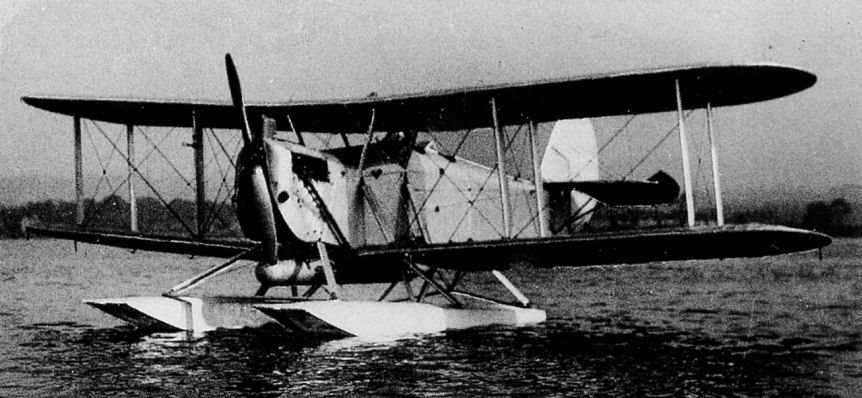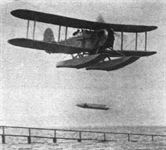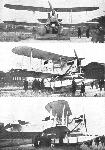
Blackburn Т.З Velos
В 1925 году фирма "Blackburn" на основе самолета Т.2 Dart разработала двухместную машину под требования ВМС Греции к патрульному самолету прибрежного действия. Главным отличием новой машины от Dart, помимо поплавкового шасси, стала установка оборудования для ночных полетов, усовершенствованной радиоаппаратуры и второй кабины для стрелка. Двухпоплавковый гидросамолет получил наименование Blackburn Т.3 Velos. В 1925 году фирма "Blackburn" построила небольшую партию таких машин, и в том же году началось их производство на основанном этой фирмой греческом национальном авиационном заводе. "Blackburn" получила все права на управление и владение заводом в течение пяти лет после его постройки. Первый Velos греческой сборки выполнил первый полет в марте 1926 года с колесным шасси, вторую машину собрали с поплавковым шасси. Всего в Греции построили 12 самолетов.
Прототип Т.3А Velos, построенный в Англии, имел металлические поплавки (вместо деревянных). В 1927 году он совершил рекламное турне по Южной Америке, но заказов не последовало. Позже Т.3А переоборудовали в двухместный учебно-тренировочный самолет. Шесть таких машин закупила фирма "North Sea Aerial and General Transport Co. Ltd" для замены гидросамолетов Dart.
В 1935 году самолеты Velos были сняты с эксплуатации, хотя последние машины утилизировали только в 1939 году.
ТАКТИКО-ТЕХНИЧЕСКИЕ ХАРАКТЕРИСТИКИ
Blackburn Т.3 Velos
Тип: двухместный самолет береговой охраны
Силовая установка: W-образный мотор Napier Lion IIВ мощностью 450 л. с.
Характеристики: максимальная скорость на оптимальной высоте 172 км/ч; крейсерская скорость на оптимальной высоте 117 км/ч; скороподъемность 198 м/мин; практический потолок 4300 м; продолжительность полета 4 ч 30 мин
Масса: пустого 1764 кг; максимальная взлетная 2812 кг
Размеры: размах крыла 14,78 м; длина 10,82 м; высота 3,73 м; площадь крыльев 60,76 м
Вооружение: 7,7-мм пулемет в задней кабине; 457-мм торпеда или четыре 104-кг бомбы под фюзеляжем
Описание:
- Blackburn Т.З Velos
- Flight, November 1925
A NEW BLACKBURN TORPEDO SEAPLANE
Фотографии
-
Мировая Авиация 57
В отличие от Dart, Velos проектировался как двухпоплавковый гидроплан. Управляемость на воде у него была превосходная.
-
Flight 1926-12 / Flight
The Blackburn "Velos" (Napier "Lion" Engine).
-
Air Enthusiast 2001-07 / A.Thomas - In the Footsteps of Daedalus
The 1925 orders for new equipment included a batch of Vickers Velos torpedo-bombers; T.12 taxying at its Phaleron Bay base.
-
Aviation Historian 7 / P.Jarrett - It's All Greek
Although it has been written that T.12 made its maiden flight from Phaleron Bay on March 31, 1926, piloted by Col The Master of Sempill, the caption on the back of this photograph reads: “The 2nd Greek machine, Seaplane Torpedo Carrier, 5min before her first flight, Wed April 7, outside our factory”. The launch was not easy, there being no slipway, so the aircraft had to be launched from the beach by an inexperienced handling party. The Greek-built examples differed from those built in Britain in having built-up rear cockpits to raise the Scarff ring for the gun. Two were fitted with dual controls for use as trainers, and several were still in service as late as 1934.
-
Flight 1927-02 / Flight
Blackburns in Greece: Our photograph shows one of the five Blackburn "Velos" seaplanes recently tested by Major H. S. Travers, D.S.C., before delivery to the Greek Government. It is the production of the National Aircraft Factory near Athens, organised by the Blackburn Aeroplane Co., and is a development of the Blackburn "Dart" and "Swift" machines, being a 2-seater torpedo-carrying seaplane, fitted with a Napier "Lion."
-
Aviation Historian 7 / P.Jarrett - It's All Greek
The ladies enjoy a day beside the seaside watching the second KEA-produced Blackburn Velos, T.12, being hauled into Phaleron Bay in April 1926. Only one of the photographs bears a caption on the reverse; it is signed by “Wallace”, presumably the Blackburn employee who took the photographs.
-
Air Enthusiast 2001-07 / A.Thomas - In the Footsteps of Daedalus
Eight of the Greek NAS Velos T3A floatplanes (T-12, -13 and -23 can be identified) and one Avro 504O on a lake at Valtoudi during an exercise in the late 1920s.
Другие самолёты на фотографии: Avro Avro 504N - Великобритания - 1920
-
Flight 1925-11 / Flight
THE BLACKBURN "VELOS" TORPEDO SEAPLANE; NAPIER "LION" ENGINE: The photograph shows the machine taking off
-
Flight 1939-05 / Flight
The Velos two-seater.
-
Flight 1925-11 / Flight
THE BLACKBURN "VELOS" TORPEDO SEAPLANE; NAPIER "LION" ENGINE: The photograph on the left shows the machine in flight, and, on the right, the Velos is shown at the moment of dropping the torpedo.
-
Flight 1925-11 / Flight
THE BLACKBURN "VELOS": Three views of the latest Blackburn torpedo seaplane, with Napier "Lion" engine.
-
Flight 1925-11 / Flight
THE BLACKBURN "VELOS": These two photographs show the nose housing the Napier "Lion" engine, and, on the right, the mounting of the torpedo between and above the two floats.
-
Aviation Historian 7 / P.Jarrett - It's All Greek
The second product of the KEA factory was float-equipped T.12, seen here being manhandled from the factory to the shore of Phaleron Bay. Another ten examples of the Velos were built by the KEA for the Greek Navy, making a total of 12, in addition to four built in Britain. Note the distinctive maw of the Napier Lion installation.
-
Aviation Historian 7 / P.Jarrett - It's All Greek
The Blackburn Velos was a two-seat development of the company’s Dart torpedo-bomber, and was designed by Maj F.A. Bumpus in 1925 to a Greek naval requirement for a coastal-defence aircraft. Although the Velos was designed from the outset as a seaplane, the first of the Greek-produced examples, T.11, was fitted with a wheeled undercarriage and made its first flight from a rough airstrip behind the KEA factory on March 17, 1926. Interestingly, the floats on this example, seen at the KEA factory without its engine cowling, bear the marking T.11, suggesting that this is the first of the Greek machines after it had been fitted with a float undercarriage.
-
Flight 1925-11 / Flight
FOREIGN ATTACHES' VISIT TO BROUGH: Standing in front of the Blackburn "Velos" are, from left to right, Lieut.-Commander Navarro (Spanish Naval Attache), Commander Guedes de Carvalho (Brazilian Naval Attache), Air Vice-Marshal Sir Vyell Vyvyan, Capt. Woodhead (pilot of the "Velos"), Colonel the Master of Sempill, Capt. Cervera (Chief of the Spanish Naval Commission), Major Davidson (United States Air Attache) and Major Rennie.
-
Aeroplane Monthly 1996-07 / G.Copeman - A backward glance
Регистрационный номер: G-AAAW [3] Shuttleworth bought this Blackburn Velos for a guinea in November 1933. G-AAAW is seen here after being flown to Old Warden by the late Allen Wheeler and Shuttleworth himself. The Velos was broken up soon afterwards to provide timber for rebuilding other Shuttleworth aircraft.
-
Aeroplane Monthly 1982-02 / A.Wheeler - Veteran Velos
Регистрационный номер: G-AAAW [3] The Velos during its visit to Brooklands on May 20, 1933, to attend the display organised by the Guild of Air Pilots. On its journey from Hooton to Brooklands, via Heston, the Velos consumed 63gal of fuel.
-
Aeroplane Monthly 1982-02 / A.Wheeler - Veteran Velos
Регистрационный номер: G-AAAW [3] Velos G-AAAW at Brough tn October 1932 with the Pegasus-engined Baffin prototype in the foreground.
Другие самолёты на фотографии: Blackburn Baffin / B-5 - Великобритания - 1933
-
Aeroplane Monthly 1981-08 / Plane Crazy
Регистрационный номер: G-AAAX [2] Blackburn Velos G-AAAX parked in a Yorkshire breaker's yard in 1933, where it remained for many years.
-
Aeroplane Monthly 1990-04 / Personal album. Civil
Регистрационный номер: G-AAAX [2] Blackburn T.3 Velos G-AAAX was built as a seaplane in 1929. Registered to NSA>, it was used as a trainer at Brough. In 1932 it was withdrawn from use and sold to the scrap dealer in York Road, Leeds where it kept company with Velos G-EBWB.
-
Aeroplane Monthly 1979-01 / ??? - Junked!
Регистрационный номер: G-EBWB [2] Blackburn Velos G-EBWB, taking pride of place atop the scrap-yard at York Road, Leeds, in 1934. Another Velos, G-AAAX, can be seen in the background.
-
Aeroplane Monthly 1990-04 / Personal album. Civil
Регистрационный номер: G-EBWB [2] Blackburn T.3A Velos G-EBWB was built in 1926 and toured South America the following year as a floatplane. Later it joined the North Sea Aerial & General Transport Co Ltd (NSA>) and was finally retired in March 1932. It was sold to a scrapyard in Leeds, where this photograph was taken on May 26, 1935; it was still there in 1939.
- Фотографии





















